

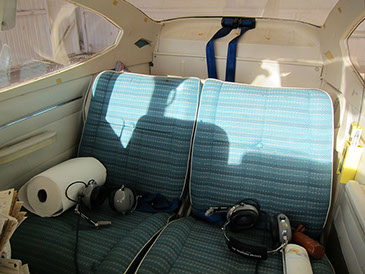
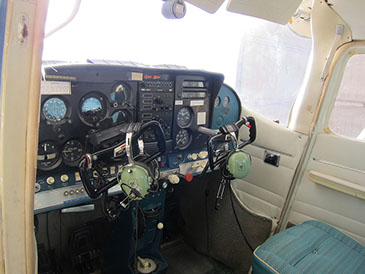
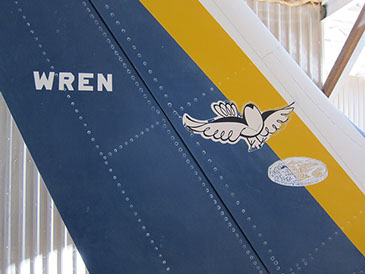
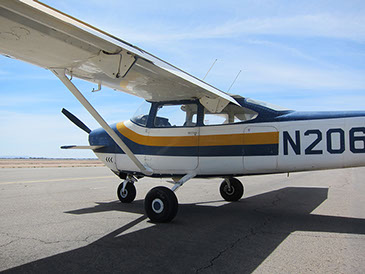

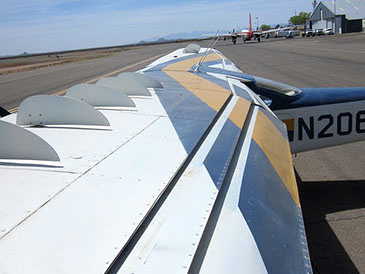
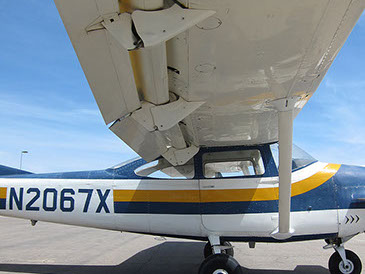
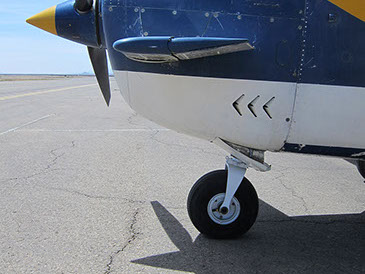
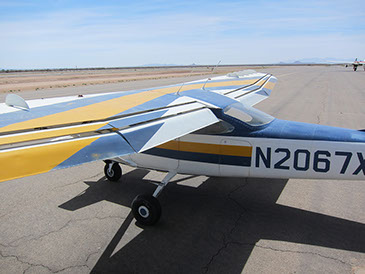
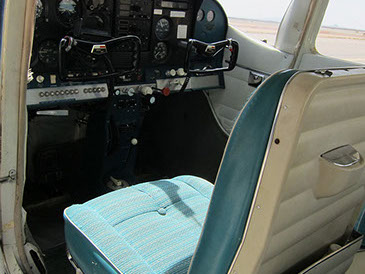
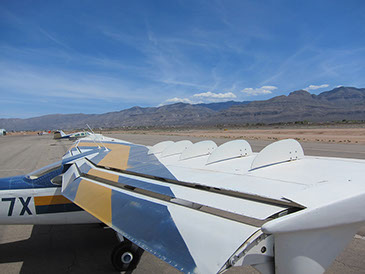
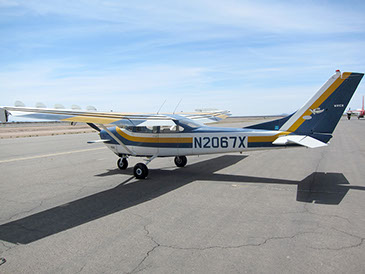
How to Research and Find your Dream Airplane
By Ron Grundy
THE BACKGROUND TO MY RESEARCH
The history of each pilot’s research for his or her ideal aircraft includes many steps. My interest in flying started around 1970. I bought my first plane, a 1967 Piper Cherokee 180, in 1973 while I was still a student pilot and used the plane to obtain my Airplane Single Engine Land Pilot’s license. I enjoyed the Piper and used it for five years, mostly on paved strips. As with most family men after getting married and purchasing a home, my plane became an expensive burden on the family. Additionally my wife worked for American Airlines and we could fly around the world at a nominal cost. So my plane was sold. But I still kept an avid interest in airplanes and aviation. I joined an EAA chapter near my home and in 1976 we went to the EAA museum on a week end and worked on a replica of “The Spirit of St. Louis” airplane. In 1980 a group of the chapter members and I attended the OshKosh Airventure.
In 1976 I had read several magazine articles about the legendary German Fieseler Storch and its STOL flying capabilities. It became my first “Dream” airplane. Very soon thereafter I actually had a chance to buy a flying Storch from an ad in Trade-a-Plane for $25,000, It had been taken in on a swap with several other warbirds and the California owner really didn’t want it. However the Swastikas on the plane didn’t go over very well with my wife and that was the end of my first dream. At about the same time I had another opportunity to purchase one and a half Storchs for $15,000 in my home state of Michigan. But the package was a basket case and would have taken a lot of time, money, and knowledge that I did not possess to put it back together. Besides I finally came to the conclusion that most warbirds are usually just show planes and the Storch didn’t have a very large load capacity or a decent cross country cruise speed.
The EAA museum included the prototype of the Helio Courier from about 1948. After researching the Courier’s flight characteristics, it became my second “Dream” airplane. It was a modern airplane with STOL capabilities and a decent cruise speed. Some time there after I actually met a Helio owner. He and his plane were very interesting. But then REALITY had to raise its ugly head and bring me back down to earth. The Helio was very expensive to buy, maintain, and insure. It also has a long wing span and needs a wide hangar. And I also didn’t have tail dragger experience. I later heard that the Helio is tough to land in crosswinds due to the weather vane effect of the large rudder at slow speeds. Even with the leading edge slats, large flaps and other STOL equipment, the Helio “hangs” on the prop to get a slow forward speed and short landing roll.
Searching further I learned that the Maule flying and landing characteristics are much more reasonable. But for me it has the same Helio concerns, it was a taildragger. I decided that I had to find a safe STOL plane with a tricycle landing gear.
I then became familiar with a low wing French STOL plane, Rallye, with a sliding canopy, which had recently started to make a name for itself. But I had already had experience with my Piper’s low wing. I had difficulty with its tendency to “balloon” in ground effect on hot airstrips in summer and also had been challenged trying to maneuver it on narrow taxi ways in Michigan in winter with our high snow banks. So I also ruled out the Rallye
MY DREAM AIRPLANE AND WHY
For several decades flying took a back seat in my life. So I had lost my keen concern about buying a STOL airplane with tricycle landing gear. But when I recently retired I again started looking for such an airplane. My interest peaked when I started reading articles about the Wren 460 conversion of the Cessna 182. This became my final “Dream” plane! The aircraft was marketed as the only safe STOL aircraft. This is because it does not achieve its STOL characteristics through high angles of attack or by depending on a powerful engine to pull the aircraft upward (operating "behind the envelope"). At full gross weight, the Wren's take-off and landing distances are 300 ft. At just above idle power the aircraft can loiter at slow speed with outstanding stall resistance and over-the-nose visibility in level flight. Because of the low approach speed, the Wren was approved for landings under Category II conditions (1/4 mile visibility and 100 foot ceilings) on Instrument Landing System approaches. The Wren Aircraft Company was even seeking approval for zero visibility landings shortly before the company went into bankruptcy in the late 1960s. An additional point of interest in the Wren 460 comes from a historic perspective. There are reports that a few "Wrens" did service with "Air America" during the late 1960’s in Viet Nam and Laos
This airplane has four seats with most airframe and engine parts being supported by Cessna and current engine manufacturers. It can fly at 55 mph in level flight for hours! The manufacturer said it can land at gross weight at 28 mph (with power) like the Storch, but nobody with whom I have talked ever lands it that slow. I’ve seen two WWII pictures of Storchs with their landing gear at right angles to each plane’s fuselage, after losing forward lift and hitting the ground trying to do this.
The safety in Wren 460 landings and especially emergency landings is due to the fact that it has several unique ULS (ultra low speed) control system elements:
1. A high lift canard mounted just behind the prop to give added lift to the nose at slow speeds.
2. A full length wing leading edge wrap- around cuff which causes a drooping appearance, but delays the stall at slow speeds
3. Full span double- slotted flaps
4. Ten “Wrens Teeth” mounted on the top of the wings that act as movable spoilers which assist the ailerons with roll control and aid in making proper coordinated turns.
5. A horizontal stabilizer that adds lift by automatically lowering its leading edge when the flaps are lowered.
The FAA certified the Wren 460 in June 1964, but the Wren was designed from the Skylark prototype which dates back to 1955. That prototype was further refined to become the Skyshark in 1962. The Curtis Tanager and Handley Page Gugnunc, both from 1929, the Consolidated Vultee (Convair) L-13 from 1945 and the Scottish Aviation’s Pioneer of 1950 must have figured in James Robertson’s final design of the Wren 460.
I have a company article, dated January 29, 1968, entitled “The Wren 460 Story” which states that the Wren Aircraft Company made only 47 Wren 460 conversions of the Cessna 182. Several of those went to Brazil, Mexico, Venezuela, Australia and Canada for oil pipe line and electric lines patrolling. One went to a safari company in Kenya and some went to England, Ireland, Papua New Guinea, Laos, Viet Nam, and Indonesia. So only a handful of the original Wrens stayed in America. Wren Aircraft Company tried fulfilling government contracts but went bankrupt in 1969. In early 1977 the assets of Wren Aircraft Company were purchased and full Wren conversions were again in production. But shortly the successor company changed the Wren 460 to the 260 SE, a design of its own. The successor company accounts for only somewhere between forty to fifty more Wren 460’s for a probable maximum total production of only 100 worldwide.
Over the years a number of Wrens were sold to buyers in foreign countries and their American registration N numbers were terminated. Some American based Wrens had their N numbers changed by new owners. Some were destroyed in accidents and taken off the U.S. registry. All of these number changes make it very tedious and difficult to locate current existing Wren 460’s and to contact their owners.
LOCATING YOUR DREAM AIRPLANE
What type of plane would you be seeking? Would you want an aerobatic, amphibian, antique, biplane, float plane, helicopter, kit plane, light sport aircraft, nose wheel, tail dragger, retractable, single engine, twin engine, war bird, ultralight, or some other type of unique aircraft? What flight characteristics would you want, such as fast flight, fuel efficient, STOL or something else? How many seats would you want: one, two, four, six or even more? Would you want a specific airplane from a well known manufacturer to benefit from easier availability, a lower purchase price, ease of obtaining replacement parts, or even lower insurance cost? These are just a few of the considerations you will want to make before deciding on your final “Dream” airplane.
So how can someone locate their personal “Dream” plane and locate owners willing to sell them their airplane?
Research is necessary. But where to look? I initially started by checking for aviation articles from 1964-1968, when the Wren 460 was originally in production. At that time Wren Aircraft Company succeeded in featuring the plane in most popular aviation magazines: Air Facts, Air Progress, AOPA Pilot, Cessna Flyer, Cessna Owner’s Magazine, Flying, Janes All the World’s Aircraft, Plane and Pilot, and Private Pilot. I located these articles at an exceptional airplane and aviation museum library in Kalamazoo, Michigan. The Kalamazoo Air Zoo library is no ordinary aviation library. They state that they have practically every issue of every U.S. and United Kingdom magazine that has been in print. Everyone is encouraged to research any plane or aviation interest there. Copies of articles are a dime a page, printed on a black and white copier, and all payments are considered a donation to the museum. I’ve packed a lunch and spent many hours there. Another library that I used was The McDermott Library, Special Collections Department at the University of Texas at Dallas. I found several original Wren Corporation documents there. There is a nominal cost for copying at ten cents a page on line, using a credit card. Contact cthomas@utdallas.edu for your special interest research. I also used the EAA museum library. I still want to use the U.S. Air Force Museum Library in Dayton, Ohio and the library at the Smithsonian in Washington D.C., but they are another couple of trips away. I have also looked for Aviation archives in Aviation Schools and other Aviation Museums on Google.
At Airport-Data.Com I found a list of thirteen Wrens made by the original Wren Aircraft Company under the title of Cessna Wren Production List. I then went to the FAA registry online at faa.gov/aircraftinquiry/NNum to check on their N number information for their current owner status. Only five are registered, the data of another two are questionable and the remaining six were either destroyed, shipped out of the country, or de-registered.
After I collected twenty five articles about the Wren from the afore-mentioned vintage magazines, I started checking the N numbers of the planes in the pictures in the magazine articles, once again at the FAA registry. After many months of research and reading articles on Google and many other search engines, I was able to locate 21 existing Wren 460’s and their owners worldwide. I have also accumulated a large list of former N numbers, pictures of “lost” and sometimes subsequently wrecked Wrens and several pictures of Wrens that were based in foreign countries over the last four decades. One Wren was wrecked in Thailand and I have information and pictures of it, somewhat intact, rusting away in a military “boneyard” there.
I found five Wren 460’s on Airport-Data.Com
I found four in Trade-A Plane over several years.
I found three as a result of checking their N numbers from pictures in magazines
I found two in Australia on a Google search for Wren 460 and Cessna 182 Wren 460.
I found two who are current members of backcountrypilot.org.
I found a Canadian Wren and one in Mexico on 260sepilots.org
I found two by contacting the owners after a check of FAA records for Anchorage, Alaska
I found one by “word of mouth”
After I obtained the owners’ addresses from the FAA registry I put together a letter to mail to each of them which stated that I’m interested in any and all information about their airplane or parts and inquired if they would like to sell their airplane or if they know of anyone who wants to sell a Wren, as I might be interested in buying one.
Two of the Wren ads that were in Trade-A-Plane were already three years old. I guessed that in the falling economy the aircraft weren’t sold and contacted the owners. One was sold at a much reduced price and the other Wren was available in Texas at an even much more reduced price. Before I went to see the available plane, I contacted two other Wren owners by phone, a result of more current Trade-A-Plane ads. They each sent me further photos and info of their planes by email. I didn’t like the condition of one in Kansas and the other one in California was very expensive because of a new higher H.P. engine with low time, but it had only one nav/comm. radio and consequently no communication switching panel. I flew to Texas to see the first airplane and was disappointed at both the interior and exterior conditions, although it appeared to be a solid airplane with a good auto pilot and IFR instruments.
A month later I flew to California to see the expensive plane. It was in tip-top shape inside and out and I was interested in it, but I chose to delay my decision until I received my medical certificate. While waiting, both the planes in Kansas and California were sold.
I soon started receiving emails and phone calls from the letters that I had sent. Several owners wanted to sell their Wren. While considering my choices, I questioned how to contact the owners by phone who had not responded to my letter? By chance I ran across the website anywho.com, which gave me the phone numbers of most of the owners. Everyone was very helpful after I introduced myself and stated that I was interested in their Wren. Several even had my letter handy near their phone, which made my phone introduction much easier.
Finally I received my medical certificate on September 1, 2011. On that same day I received a phone call from an owner in California who wanted to sell his Wren. After I received several pictures and a list of pertinent data about the plane and equipment, we set a price subject to my inspection and set a tentative date for me and an A&P mechanic to fly out and inspect the plane. The annual inspection of the airplane was due so I wanted that completed before I came to purchase it. As more delays developed, I told the owner that I’d have to lower my offered purchase price several thousand dollars as it was getting late in the year with shorter daylight hours and bad weather seasons approaching over the mountains and the entire route to ferry the plane to my home in Michigan. I was concerned about getting weathered-in and paying my mechanic extra days and extra hotel stays, etc. Besides after it was flown back home, I would have fewer “good” flying weather days to get certified in the plane before next spring.
After several more weeks we flew commercially to California. When we arrived, the owner picked us up at the airport and said a brake line on the plane was defective and needed to be replaced. We tried to find a replacement part, but none was available on such a short notice. My mechanic analyzed the problem and temporarily used another spare brake line in the hangar to allow us to fly it home if it otherwise met our inspection. My mechanic went over the plane for eight hours and found numerous small repairs that weren’t done on any annual for the last three years. He noted the repairs to the seller and discussed the cost of the prospective repairs.
Fortunately someone had already alerted me to a story about someone else who had bought a plane out of state. Since it just had its annual inspection completed, he paid the agreed price. When the buyer had his mechanic inspect the plane at his home base, there were THIRTY-NINE minor and major repairs that needed to be immediately corrected at a considerable extra expense. With that forewarning I had the foresight to have a certified check made out for an amount lower than the second agreed price and carried cash to make up the difference, if my mechanics inspection revealed everything was perfect. When signing the paperwork and completing the deal I simply told the seller that there are many repairs that will need to be done when I get home and therefore I wouldn’t pay the last agreed purchase price. I gave him the certified check and added a few more dollars. He understood fully, there was no argument and we loaded the plane!
On that first day we flew four hours over the mountains in daylight to our first overnight stop. The next day we flew twelve hours in three four hour segments reaching home at 3:00 A.M. the next day! I must say that we had the smoothest flight and clearest sky imaginable for the entire flight and our ground speed averaged 160 knots. I believe that is about a 40 M.P.H. tail wind, which saved a lot of time and gas.
By the way after we got home my mechanic’s bill for the parts and labor my Wren needed after the so called “annual inspection” in California was $4,500.00!
NOW IT IS YOUR TURN
As you can see there are many steps to finding and obtaining your “Dream” airplane. Certainly if you just want a common airplane or a kit plane of your “dreams”, there is not much more to do but pick up a current issue of Trade-A-Plane, check the ads on barnstormer.com or place a “wanted “ advertisement for your plane in each of those marvelous venues .
But if you’re wanting to find a rare airplane with flying characteristics that fit your personal interest, as I did, you will need to have patience and do a lot of research, join your local EAA chapter, do a lot of “hangar flying” and ask many questions about your favorite airplanes at your local airport, check articles in popular flying magazines, and check all the online search engines. With basic and advanced research, you’ll be much more informed for that major purchase.
I’m always looking for more information on the Wren 460 and want to converse with all current or past owners or anyone who has any information about the Wren 460. If you know of anyone who might not have read this article, please pass this information on to them.
I’m Ron Grundy and live in Hartland, Michigan and can be reached at molders101@yahoo.com
(Sadly, Ron Grundy has passed away. But, for the benefit of all of us, he worked diligently to assemble obscure information on the original Wren 460. Most of the information on this website, www.WREN460.com, was provided by Ron).
©2022 Wren 460
Contact: (575) 405-0911 C3@netmdc.com